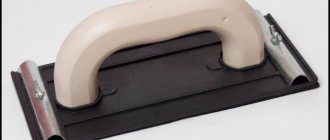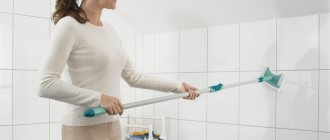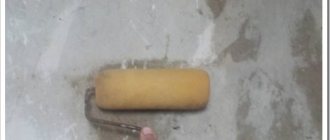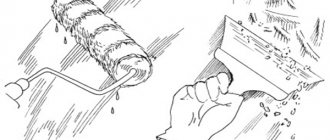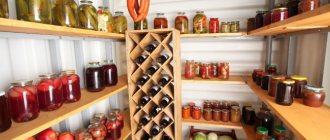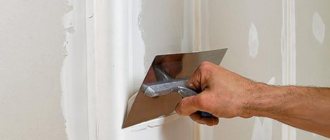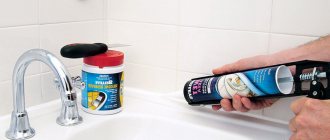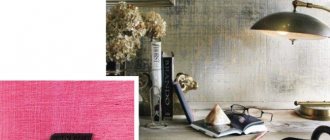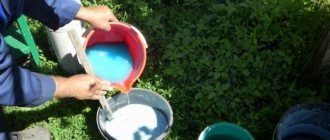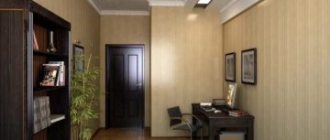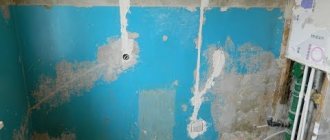Special remedies for fungus
Most manufacturers of building mixtures and paint and varnish products produce various anti-fungal products.
It is important to describe the problem to a specialist so that the employee can help you choose a suitable product against a specific type of mold. Solutions must correspond to the material to which they will be applied and not spoil it.
The most popular solutions:
- Atlas Mykos - sold in the form of a concentrate, can be used for interior and exterior use, including on mineral surfaces.
- Spectrum - used on wood, putty, painted surfaces, and at high humidity.
- Teflex is an environmentally friendly product that can be applied to walls in a child’s room.
On the walls you can use Antisept, Abedis, Xiolat, Snezhka Impregnation.
Antiseptics in solutions
Typically, solutions are used when the area affected by the fungus is quite large. The drugs are sold in large containers - jars, canisters, and have a ready-to-use form. The concentration of the solutions is safe for humans.
They are applied with a sponge, erasing most of the mold. Usually 1-2 treatments are enough to get rid of the fungus, but then for prevention you can add the product to the water for cleaning the room.
List of the best solutions with fungicidal additives:
- Dali;
- Fongifluid Alpa;
- Olympus Stop mold;
- Biotol;
- Mavix-Bio.
Primers - antifungal
Primers can be used to carry out treatment even at the stage of construction or repair. Good products are sold in any specialized stores; almost every brand of building materials has them. Excellent quality is observed in the soils Milkill (MilKill), Terragrunt, Kremen, Lakra, Auburn.
Most products have the ability to penetrate deeply into the pores of the base. Anti-mold components are introduced into the smallest crevices of concrete, and other substances fill the pores from the outside. To avoid problems with mold for a long time, it is better to treat any surfaces during repairs with similar soils.
How to treat plaster?
If mold is found on the surface, cleaning occurs. Use a spatula or sandpaper to remove the fungus from the plaster. The surface that has been affected by mold is treated with chemicals or compounds that every housewife has at hand.
Before cleaning the plaster, a test is carried out to determine the adhesion strength of the material and the wall. The check consists of the following steps:
- We tap with a hammer on the surface of the wall at different points, including those where mold was found.
- If a person hears a dull sound when tapping, then it is necessary to remove all the plaster material, as it has become unusable. Therefore, the surface is covered with a new layer of plaster.
- If the plaster is firmly adhered to the wall, they begin to clean the affected surface and apply an antiseptic.
When working with plaster, various chemicals are used.
Copper sulfate for mold and mildew
Before treating the walls with copper sulfate, you should prepare them. But first of all, remove everything unnecessary from the room: furniture, linen, household appliances and more.
Carefully inspect everything removed for the presence of mold. She can hide on the legs of the bed and sofa, on the back wall of the closet and its bottom. Things need to be disinfected. Otherwise, they may be a new source that will re-infect walls and other surfaces. And you will have to carry out all the processing and disinfection manipulations again. To prepare the walls, do the following:
- First you need to find the main source of mold. It can be in the most difficult to reach places, for example, under tiles. You need to tap the tiles; if there is a void underneath, it is likely that there is fungus there. In such areas it is better to remove the tiles. Mold can also hide under the wallpaper. They will have to be removed too.
- After mold is found and the walls are cleared of tiles, wallpaper and other coverings, begin cleaning. Take a metal spatula or stiff brush and remove all plaque. Then go over again with low-grit sandpaper.
- Next, wipe all the walls with soapy water and wait until they are completely dry. This will make treatment with copper sulfate more effective.
Copper sulfate is available in dry form, so it is diluted in water. You need to take 100 grams of blue powder and pour it into a metal container with 10 liters of water. The water should be warm. Mix the granules well in the water until they are completely dissolved.
Pour diluted copper sulfate for wall treatment into a spray gun or spray bottle. Apply thickly to all affected areas. If you don't have a spray bottle, use a regular kitchen sponge. After 3–5 hours, copper sulfate should be sprayed again against mold in all treated areas.
The product will dry completely only after 2-3 days. Limit your time in the contaminated room to a minimum.
- Wear thick rubber gloves, a respirator or cotton-gauze bandage, safety glasses and special clothing. Tight, closed clothing with long sleeves is suitable.
- After disinfecting surfaces and walls, ventilate the room well.
- Clothes used for treatment should be washed separately from other laundry and dried in fresh air.
- If you experience slight malaise, dizziness, headache, nausea or allergic rashes, consult a doctor immediately. These may be signs of poisoning.
Folk remedies for mold
The easiest way to treat walls is to use non-traditional means that are cheap and accessible. It is not recommended to remove large accumulations of fungus using these methods, since they are weaker (with the exception of copper sulfate). After the initial treatment, repeat treatments are done 7–10 days later.
Soda
Mold removal can be done using regular baking soda. This is a universal disinfectant that will not harm humans or pets.
Soda in the amount of a tablespoon should be diluted in a glass of water, then begin to treat the affected areas. The solution is poured into a sprayer, the walls and ceiling are irrigated. After an hour, you need to wash off the soda with water and wipe the base dry with a cloth.
Hydrogen peroxide
The product can be applied to walls in its pure form, without dilution. Peroxide does not produce harmful fumes, and the liquid is not toxic. You just need to be careful with wallpaper, because the solution has bleaching properties and can leave white spots on the surface after drying.
Peroxide can be used together with other components in the following recipe:
- take 4 parts water,
- add 2 parts vinegar, the same amount of boric acid,
- add 3 parts peroxide (3%),
- Apply to the fungus, leave for an hour, rinse.
Vinegar
Using vinegar helps against mold. Table vinegar is poured into a sprayer and the walls or ceiling are irrigated. Then rub with a cloth and leave for 2 hours. Then carefully wash off the vinegar from the surface.
Copper sulfate
Sold in packages in the form of dry powder. About 100 g of vitriol should be poured into a metal bucket, add 10 liters of warm water. Stir the mixture until the powder is completely dissolved. Pour the drug into a spray bottle and treat the affected areas of the apartment. You can use a foam sponge.
The solution should dry for 3 - 5 hours, then it is sprayed again on the same places, and so on up to 2 - 5 times. In advanced cases, you must first remove the putty and finishing material. It is not advisable to stay in the room for 3 days, then the fumes of copper sulfate will stop being released.
Laundry soap
Soap solution is a good antiseptic. Laundry soap is dissolved in water, then the walls are washed in a convenient way. After a couple of hours, wash off the remaining soap with water.
Ammonia
Ammonia can only be used on smooth, hard surfaces, and the product will be useless on porous substrates. Ammonia is mixed with water equally and sprayed onto fungus-damaged areas. Wash off with water after an hour.
Borax
Borax is a non-toxic product of natural origin that has powerful fungicidal properties. Destroys mold and prevents its reappearance.
Before using borax, you need to clean the surface with a vacuum cleaner so that fungal particles do not fly through the air. Then you should prepare the solution, observing the correct proportions.
Take a glass of borax from the bag and dilute it in 2.5 liters of water. The solution is applied to the base with a stiff brush, while simultaneously removing the fungus. The borax should be allowed to dry completely; there is no need to wash it off.
Bleach
Many bleaches contain sodium hypochlorite or other forms of chlorine (eg, Bleach). This additive is very effective against mold and can even replace professional fungicidal preparations.
Bleach is used only on surfaces that are white, otherwise it will not be possible to avoid unsightly stains and damage to the coating. Bleach can be used on tiles and glass, but it is not used on drywall and wood.
Due to its toxicity, working with chlorine must be done with caution. Protect your hands with gloves, and put a respirator on your face. Dilute the drug 1:10 with water and apply to damaged areas using foam rubber or a brush. After complete drying, the surface is cleaned and washed with water.
Other folk recipes
Tea tree oil is a natural antiseptic. Pour a teaspoon of oil into a glass of water and spray the walls and ceiling where the mold has settled. There is no need to rinse off the solution - the product is absolutely harmless to humans.
You can also treat surfaces against fungus using a solution of potassium permanganate. Pour ½ teaspoon of potassium permanganate powder into a liter of water, spray the walls or gently wipe them.
Some people use office glue for mold. It is diluted 1:1 with water, after which small areas with mold can be treated with the product.
Ways to fight fungus
If mold appears, you need to take measures to remove it. This can be done both with the help of branded antiseptics and folk remedies.
Removal of fungus is carried out as follows:
- First of all, we determine the source of the fungus. The mycelium may be located in a hard-to-reach place, for example, behind tiles or under plumbing fixtures. In this case, plaque on the tile can only be a consequence of a mycelium that is invisible at first glance.
- When the source is detected, we begin to scrape off the mold. Clean the scraped area with a hard-bristled brush. When looking for the source of the problem, it is recommended to tap the tiles to find any voids. Where they exist, you need to remove the tiles and clean them.
- If fungus is found in the grout between the tiles, the entire grout mass is removed.
- We warm up the cleaned areas with a hair dryer or a powerful heater. It is strictly not recommended to use hot water to warm the affected areas. Warming up should only be dry.
- We treat the walls with antiseptic and waterproofing agents.
- We warm up the air in the bathroom well.
Traditional methods
One of the most effective remedies in the folk arsenal is creosote, made from tar. This material has long been used to treat structural materials against rotting. Creosote is a yellow, oily liquid with a strong odor. The material is difficult to dissolve, so to dilute it you will need alcohol.
Note! Creosote emissions are hazardous to health. Therefore, after use, traces of the substance must be removed using household chemicals.
Vinegar is also popular as a fungus killer. We are talking about ordinary white vinegar, which is used in cooking. Vinegar is a product of natural origin and is completely safe for health. The only drawback of this product is the strong smell, which, however, soon disappears.
To remove mold, you need to soak a sponge in vinegar and rub the problem areas with it. After the surface has dried, it must be treated with a brush with stiff bristles. Cleaning is completed by rinsing the surface with warm, clean water.
Another effective remedy is hydrogen peroxide. The solution has a bactericidal effect. The disadvantage of peroxide is that it leaves whitish marks on colored surfaces. Although hydrogen peroxide is non-toxic, a highly concentrated solution (more than 3%) can cause skin burns.
In addition to the above, some other means have also shown effectiveness, including:
- laundry bleach;
- baking soda;
- bleach-based cleaning products;
- ammonia;
- copper sulfate;
- boric acid;
- inkstone;
- tea tree oil.
The most unsafe products include chlorine-containing solutions. To ensure the safety of your skin and respiratory tract, you must use protective gloves and a respirator when using such products.
The process of removing mold from damaged areas
At the first stage, it is important to identify why the fungus has settled in the room. This will help address risk factors and prevent problems from occurring in the future.
It is necessary to thoroughly inspect the affected area of the wall for the presence of voids between the plaster and the base. By tapping the wall with a hammer, you can quickly identify places where the plaster has separated by the dull sound. Such areas must be repaired by removing the entire area, otherwise the mold will take up residence in its original location.
Fungus Removal Tools
To get rid of the problem, you need to prepare in advance rags, a basin and bucket, a brush, a roller, a sprayer, personal protective equipment and a solution with a fungicidal effect.
A metal spatula will be needed to remove the affected plaster. You need water to moisten the affected area so that fungal spores do not spread indoors by air.
Working in the bathroom
The most vulnerable areas in the bathroom are the joints between the plumbing fixtures and the walls, which are usually treated with sealant. Mold most often settles in the seams between slabs, in the area of socket boxes. If there is an indelible black coating there, it is most likely a fungus.
Work order:
- Remove moldy sealant or other material on which fungus has settled.
- Treat the area with the selected product.
- After drying, reapply sealant or other polymer.
- If fungus affects the seams between the tiles, scrape it off with a metal spatula or scraper.
- Apply grout with added fungicides.
It happens that mold settles in the bathroom ceiling. Then you will have to moisten the area with water, leave it for an hour, then scrape off the plaster with fungus. Next, you need to putty and prime the area with a special product with anti-mold additives. As it dries, apply another layer of soil that has the ability to penetrate deeply. Then the ceiling can be sanded and painted.
Removing fungus on walls and wallpaper
If fungus is noticed on the wall in the apartment, it must be removed without delay - within six months the mold will “grow” to the concrete base. The damaged finish must be removed by first sprinkling with water, and all deposits must be thoroughly cleaned. After drying the wall, it is treated with a fungicidal agent.
Drywall and wood should be treated with the strongest means, because the fungus spreads very quickly and penetrates deeply.
Mold spreads across the wallpaper at lightning speed, so you will have to remove the entire strip or even several. After removing the wallpaper, you need to check whether the affected layer covers plaster, concrete or brick. It may be necessary to carry out a major renovation by completely removing the trim.
Working against fungus on wood
There are special impregnations for wood, which contain antiseptic and fungicidal additives. Anti-fungal agents are applied to a dry surface from which areas of mold have already been manually removed.
Impregnation should be applied at least 3 times, and each layer should be allowed to dry. To complete the work, apply a layer of primer suitable for wooden surfaces.
Causes of fungus
Not all citizens have an idea of where mold appears and why it happens. There are several global reasons:
- Lack of ventilation in the room, which causes dampness to accumulate in it.
- A large number of indoor plants concentrated in one place.
- High humidity.
- Problems with heating systems.
High humidity
High humidity is considered one of the main causes of mold in the house. Sources of high humidity can be:
- leaks in heating or water supply systems;
- accumulation of condensation on windows and in the bathroom.
If these sources are not eliminated in a short time, mold will not take long to appear.
Poor ventilation
The second most common cause of fungus is the lack of room ventilation. This provokes an increase in humidity, which leads to the explosive growth of fungal spores. Periodically check ventilation grilles and air ducts, cleaning them from dust and dirt.
Heating problems
Problems with the organization of heating in the room lead to sudden changes in temperature, and, consequently, the formation of condensation. At the initial stages this does not pose a threat, but over time it becomes more and more common. If nothing is done, after some time a mold colony will begin to form in this area.
A large number of plants
The appearance of mold spores in flower pots is a common occurrence due to the following reasons:
- frequent watering;
- low room temperature;
- lack of drainage, which leads to stagnation of moisture in the soil;
- high soil acidity.
All these factors, combined with a large number of plants in one room, lead to the appearance of spores on the walls and ceiling.
Causes of fungus
The main cause of infection is dampness.
Mold and mildew, which often infect our homes, are close relatives of ordinary forest mushrooms, which many of us love to collect.
The mycelium itself is located deep in the nutrient layer, and what we see from the outside are only its fruiting bodies that appear during ripening - for the spread of spores.
If for forest mycelium the nutrient base is soil, then for “domestic mushrooms” this role is played by construction materials.
Moreover, the fungus is extremely unpretentious and can equally well grow on wood, brick, concrete, drywall, etc.
The only condition necessary for the growth of mycelium is high humidity and above-zero temperatures.
And the higher the humidity and temperature in the room, the better the conditions for the rapid growth of microscopic fungi.
Before you begin to fight them, you should find out and eliminate the cause of excessive dampness. Without this, any attempts to get rid of unwanted neighbors will be doomed to failure.
Favorable conditions for the development of mold on wallpaper can be created for several reasons:
Ineffective ventilation systems
Fresh air must circulate.
To check whether they are functioning at all, just bring a lit match or candle to the ventilation grille.
By the vibration of the flame, it will be possible to immediately determine whether there is air flow in the system, as well as its intensity. If there is no air movement, then most likely the system is clogged or blocked somewhere.
Low quality plastic windows
Low-quality windows do not provide ventilation.
Often the cause of condensation accumulation in a room is low-quality plastic windows. In pursuit of savings, homeowners purchase economy-class windows made from a cheap profile that does not provide special valves for gas exchange in the room.
As a result, the room is simply sealed: the accumulated moisture has nowhere to go, and it settles on the internal surfaces in the form of tiny condensation.
The situation is aggravated by an insufficiently powerful ventilation system and walls made of moisture-proof materials.
Moisture penetration from the roof or basement
Dampness can also enter the room from outside. For example, if there is a leaking roof or insufficient waterproofing of the floors between the living room and the basement.
Accumulating under the wallpaper, dampness becomes a favorable environment for the development of fungus.
To eliminate this problem, first of all, you should repair the roof or improve the waterproofing of the floor. There are ways to remove mold from wallpaper.
Non-compliance with construction technologies
A variety of violations of building regulations can cause walls to become damp. This can be the use of materials with waterproofing properties for interior wall decoration, as well as:
- Pasting walls with water-repellent materials, such as roofing felt or plastic film.
- Using vapor-proof materials as insulation - polystyrene foam, penofol, penoplex, etc.
- Wallpapering walls with non-woven wallpaper.
After all the immediate causes of mold have been eliminated, you can begin to fight the fungus.
Mold removal algorithm
Mold can be completely removed only by carrying out comprehensive measures to destroy the fungus and taking measures to protect the home from re-infection. The main actions:
- ventilation of the room for drying;
- treatment of all surfaces with special means;
- organization of high-quality waterproofing.
Step-by-step removal of mold from a room
When mold appears on the walls, residents often dream of getting rid of it at low cost. But this, unfortunately, is impossible.
Sequence of actions when ridding a room of mold.
- First of all, you should tear off all the wallpaper. You should not leave even those areas of the wallpaper that seem uninfected, since the mold will definitely appear again and will have to be removed again. Be sure to go over the walls in all rooms with a spatula and a stiff brush to remove every single mold pore, remove paint, putty and plaster.
- All surfaces are treated with an anti-fungal agent on the walls. You can use the most ordinary “Domestos”, but the best results are obtained by specialized products: “Senezh Effo”, “Fongifluid” (ALPA) or “Homeenpoisto” (TIKKURILA). If the humidity in the apartment does not exceed 60%, and the stable temperature is not less than 20°C, then it will take about 5 hours for the products to completely dry.
- After complete drying, all surfaces are cleaned again with a brush. It should be remembered that the brush must be dry.
- The walls are thoroughly washed to completely get rid of mold pores.
- If the mold in the room has grown significantly, the treatment procedure will need to be repeated after several days. The same applies to processing if the room has very porous walls.
- After the last treatment of the room with an antiseptic, at least a day should pass. After this period of time, you can begin treating the surfaces with a primer. It is better to purchase the following types for this purpose: “Tiefgrund LF” (DUFA) or “Euro Primer” (TIKKURILA). The primer is applied undiluted. Its application is necessary for better protection against the return of fungus, as well as to increase the air permeability of the walls, strengthen them and better adhesion to subsequently applied layers of finishing.
- Now you should plaster the walls, apply the primer again, wait for it to dry and glue the wallpaper. Pasting walls after mold removal has its own specifics - you can only use glue with antifungal properties. “Special Vinyl” (Kelid) and “Special Non-woven” (Quelyd) are well suited for this purpose.
- If you decide to paint the walls rather than wallpaper, you should give preference to paint for rooms with high humidity. This paint ensures that the walls are dry, which means that the fungus will not appear again.
Causes of occurrence on walls and plaster
For mold to grow in a room, a combination of three factors is necessary:
- Presence of spores in the air. If the premises are maintained correctly, mold will not be a problem in your home. Otherwise, the spores come to life and settle on the wall. The fungus begins to multiply.
- Availability of a nutrient medium in the room. These are walls made of different materials, dirt, dust, soil from indoor plants.
- A certain indoor microclimate. The temperature in the house should be approximately 20 degrees Celsius, humidity - more than 60%. In addition, we add uneven heating and a ventilation system that does not work correctly.
Particular attention must be paid to the correct installation of ventilation. If equipment operates correctly indoors, the movement of air currents interferes with the spread of mold on the walls. Where there is no air movement: corners, surface seams, mold can be found.
Causes of mold on walls
Provoking factors:
- poor ventilation;
- low quality brickwork;
- improper arrangement of the insulating layer;
- owners rarely ventilate the premises;
- the apartment or house has plastic windows and there is no regular access to fresh air;
- the walls are not insulated, and in frosty weather the structures freeze;
- Moisture often accumulates in the bathroom in the absence of a built-in fan. After water procedures, the couples enter the living quarters;
- the housewife often dries large laundry and clothes on radiators;
- poor penetration of sunlight. The problem often arises for residents of the first floors if tall trees with a spreading crown grow near the house;
- leaking pipes in the bathroom, toilet, kitchen. Combined with poor ventilation, dampness and a musty smell can be felt throughout the entire apartment;
- air humidity in the home exceeds permissible standards;
- There are thick, heavy curtains hanging on the windows, making it difficult to access light and fresh air;
- the housewife rarely washes double-glazed windows, which affects the amount of sunlight;
- in cold weather, the heating system is temporarily faulty or for a long period at temperatures below +10 C...+15 C, the radiators heat poorly, the temperature in the home is below sanitary and hygienic standards.
Spoiled aesthetics and more
Dark spots of fungus will appear in the future on the wallpaper
Penetrating deep into building materials, they begin their destructive activities. Dark spots on the wallpaper, gray-green stains on the walls, an unpleasant slimy or shaggy surface of the affected areas are unlikely to add aesthetics to your interior.
At the same time, being in the vicinity of such representatives also does not bode well for the health of the apartment’s inhabitants - allergies, asthma and other diseases can be caused by these tiny living organisms.
Their distinctive feature is their reproduction by spores. Spreading with dust throughout the house, these spores fill all its corners. Once on the skin, mucous membranes or in the respiratory tract, they become a source of allergens and toxins.
Effective fungal remedies
You can’t watch indifferently as the fungus takes over new areas: the more dampness there is in the home, the more actively mold multiplies. Against the backdrop of an unfavorable microclimate, the risk of developing serious diseases increases: asthma, tuberculosis, allergies, dermatological problems.
Six steps to eliminate mold on walls:
wear protective clothing, medical mask, gloves
Precautionary measures must be observed: microscopic mold particles, when entering the body, lead to dangerous consequences; take a metal brush and carefully remove finishing materials and unsightly, harmful stains from the wall; after removing paint, wallpaper, bamboo covering, and other decor, carefully remove the layer of plaster; treat concrete with fungicides. If mold develops due to improper waterproofing, you will have to reapply a liquid product to protect the walls from moisture; the next stage is plastering the surfaces
Over the course of three to four weeks, monitor whether the surface becomes damp. If the waterproofing is applied efficiently, then the problem situation should not recur; then apply a primer with antifungal components again. After the composition has completely dried, you can glue wallpaper or decorate the walls using other materials.
Chemicals and fungicides
Antifungal compounds are applied after surface preparation. Fungicides give positive results in the fight against mold. To destroy the mycelium, you need to carefully remove the layer affected by mold fungi and complete all stages of work. If the wall is poorly treated (it is necessary to remove all layers of decor, apply fungicide to the concrete base or wooden walls), then the risk of re-development of the dangerous phenomenon is increased.
When spraying compositions and using solutions, you need to protect your hands, respiratory tract, and eyes from the penetration of particles of synthetic preparations to kill mold. Before starting treatment, other household members must leave the home so that when removing microparticles there is no contact with hazardous components.
Effective fungicides:
- Biorepair.
- Tamak.
- Anti-mold.
- Antifungal.
- AMMX.
- Silit BANK.
- Savo.
- Glutoclean.
- Capatox.
- Sniezka.
- Biostop.
- Sanitol.
- Reinex.
- Volozhka.
- San Klin from mold and mildew.
It is necessary to strictly follow the processing rules: on the packaging of the drug there are instructions with a detailed description of the process
It is important to know that with deep penetration of mold, repeated treatment is often necessary with a certain interval between procedures
Folk
If small mold spots are detected, you can test the effect of folk remedies. Natural names with antifungal effects are less effective than synthetic drugs; re-formation of mycelium in the treated areas is possible. If the owners decide to fight mold using home remedies, then they must follow the same rules as when applying synthetic preparations. If you have deeply ingrained mold, you should not waste time using essential oils, vinegar or bleach: only powerful chemicals (fungicides) can completely destroy the mycelium.
An important point is the prevention of mold. Without changing the microclimate in the apartment and eliminating dampness, spores of dangerous fungi will again begin to germinate in corners and on walls.
Folk remedies for removing mold in the home:
- concentrated chlorine bleaches;
- essential oil of eucalyptus and tea tree (compositions with pronounced antiseptic properties);
- a mixture of 9% vinegar and regular baking soda;
- compositions with chlorine for cleaning surfaces in the bathroom/bathroom and sanitary products (Domestos, Belizna);
- soap solution with the addition of natural tea tree ether. The product is effective only at the initial stage of mold development.
How to remove mold
Mold on walls does not go away on its own. Special means will be required to combat it. Self-prepared solutions do not always help solve the problem.
Effective methods of combating mold are determined by the surfaces and materials on which the mold appears.
Mold Remedies
| Name of solution | Application |
| Pufas AMSS N142 without chlorine | Removes mold from masonry, shingles, slate roofing, concrete slabs, gravestones, wood, glass, tiles. For indoor and outdoor use. Sanitizing agent for pre-treatment of the substrate before painting work. Without chlorine and odor. |
| Septocyl Antimold | Destroys mold on any surface: wood, concrete, brick, plaster, drywall and others. Scope of application: residential premises, farmsteads, houses, baths, saunas, rafters, ventilation systems. |
| Sniezka Puma | Used against bacteria, fungi, mold, algae, moss, lichen and yeast on walls, plaster, adhesive and emulsion paint coatings. Can be used indoors and outdoors. |
| Prosept Fungi Clean | For removing and destroying mold, mildew, moss, algae from wood, concrete, drywall, artificial and natural stone, plastic. Removes deeply ingrained dirt from ceramic tiles and joints. |
| Glutoclen (spray) | For removing mold from absorbent substrates: wallpaper, plaster, masonry. |
| GraSS Bimold | For cleaning building surfaces, floors, walls, drains, drains, bathrooms, tiles, showers, sinks. Removes deeply ingrained compounds. Effectively cleans wooden surfaces in saunas and baths. |
| Antiseptic impregnation "Anti-mold" | For all types of bases. Used to protect wood and any other building materials from the action of mold fungi. Used as a protective impregnation for the treatment of wooden walls, beams, load-bearing beams, floors, joists, rafter systems, window and door blocks, wooden furniture |
Mold on wood
Mold spores can eat the entire tree. They get into the very heart of the wood and eat it. The softer the wood, the faster the fungus eats it.
It is impossible to get rid of mold spreading on wood. Wood absorbs moisture like a sponge. The best remedy for mold on wooden walls is to pre-treat the wood.
Before starting construction, you need to use special solutions that prevent the development of mold fungi.
Mold fungi are a wood defect.
Mold on wallpaper and drywall
Wallpaper and drywall are made from those building materials that mold affects to the very foundation. It is pointless to protect them in advance or try to get rid of mold that has appeared.
There is no point in treating drywall with antifungal solutions. The affected surface is easier to replace with a new one.
The development of mold on the surface of finishing materials inevitably leads to their physical destruction of the surface.
Mold on brick
Brick has a porous structure, so mold spores can grow inside. The easiest way to remove mold is from exposed brickwork.
To do this, it is necessary to clean and wash the surface of visible formations. Then repeated surface treatment with special solutions is required.
If there is interior finishing (plaster, concrete) on top of the brickwork, complete removal of the finishing materials will be required.
Surface treatment of finishing materials on top of brickwork will not give positive results. After all, the exact boundaries of the distribution of mold mycelium on a brick are difficult to determine and see.
You can remove mold on brick walls using DALI universal antiseptic.
Mold on concrete
Mold on a concrete wall occurs because the material can become wet, crumble, and crack. Cracks form, microvoids into which mold spores penetrate.
In order to remove mold, you will need to completely clean the concrete surface.
It is necessary to remove the interior trim, wash and dry the surface. After this, the surface must be treated with special antifungal agents.
Concrete absorbs moisture very well and deeply, so the use of special products gives a positive result. Concrete walls can be dried after treatment by turning on a heat gun.
Mold on walls is a participant in the process of biocorrosion and biodegradation of materials.
Mold on tiles
Mold fungus cannot penetrate into tiles.
Mold mycelium begins to grow in the seams between the tiles. The mycelium penetrates the structure of the mortar, feeds on it and destroys the masonry.
Seams can be cleaned using household disinfectants: Cilit Bang, Veksa.
Aluminum and plastic
Mold cannot penetrate the structure of these materials. But often finishing materials from these building materials are made voluminous and embossed.
Dirt can accumulate in the joints, bends, reliefs and protrusions of these materials. This is where mold spores begin to germinate.
You can get rid of moldy fungus only by maintaining their regular cleanliness. It is advisable to use household disinfectants, as in the previous case.
General operating principle
The specifics of the manipulations are distinguished depending on in which room - residential or non-residential, warm or cold, ventilated or not - the infection occurred.
The following are considered mandatory:
- complete removal of the affected layer of material;
- treatment after mechanical cleaning with antiseptics;
- Complete drying and ventilation of treated surfaces before new finishing.
All work is carried out in personal protective equipment! Before mechanical cleaning, the surface is wetted - this will prevent mold spores from spreading with dust throughout the rooms.
What to do:
- completely remove the old finish. If there is mold on the walls, it is almost certainly present under the floor and ceiling coverings, in secluded places under the windowsill, behind the radiator, under the baseboards and threshold;
- identify all affected areas and the depth of the affected layer. To do this, it is necessary to knock the base plaster off the surface in several places and check how deeply the mold mycelium has penetrated. The depth can reach 5...10 mm, depending on the density of the material;
- clean the surface mechanically (with a brush, a special attachment for an angle grinder or drill, sandpaper, or a grinder);
- treat cleaned walls with an antifungal agent;
- perform a new finish after the surfaces have completely dried.
Deciding which product to use against mold and mildew on the walls of an apartment should depend on whether the room will be used as a living space and what kind of finishing will be used.
The same sequence of actions is used here as when processing walls. The only difference is that it is much more difficult to remove the finish from such surfaces, and creating it anew is more expensive and time-consuming.
Important: you cannot install new coatings after only slightly removing visible elements of the damage! Under a new suspended ceiling or laminate flooring, mold will grow even faster and more extensively!
Secluded places
These include hard-to-reach corners in the seams between facing tiles and panels, places under thresholds, window sills and baseboards, boxes for wiring and communications. Since it is difficult to reach such corners with large mechanized tools, it is better to use hand-held metal brushes, chisels, miniature cutters and abrasive attachments.
Particular attention is paid to the seams between the tiles and facing panels. Here you need:
- wash the surface of the cladding with active detergents (Domestos, Belizna and analogues). This will help you figure out where the dirt is, where the mold is;
- remove the grout between the cladding elements. It is advisable to do this with a special tool;
- treating the space between the tiles with a concentrated antiseptic;
- new seam sealing.
The main types of fungi on walls
Mold, which is found on various surfaces, develops from fungal spores: in a “dormant” state, they are in the air. When favorable conditions develop for them, they begin to multiply and settle on the walls. Usually you can see black mold in apartments and office premises. Its presence on surfaces is caused by fungi of various strains: Ulocladium, Cladosporium, Penicillium, Alternaria, Aspergillus, Chaetomium, Phoma, etc. Pathogenic microorganisms are harmful to human health: they must be gotten rid of as soon as possible.
Mold on the wall in the apartment: what to do
Most often, moldy spots or “caps” are discovered during repairs or general cleaning. Regardless of where they are found, it is necessary:
- examine the affected object, find out the boundaries of infection;
- find – if possible – the cause of the mold. It usually occurs in places with constantly high humidity and temperature;
- remove the reason. If the stain is found on the ceiling, check the roof/ceiling for leaks. If it is on the wall, identify the source of moisture and remove it. If mold fungi grow in the space under the floor (between the joists, on the joist supports, on the underside of the boards), the humidity should be reduced and ventilation should be provided. If the mold is distributed relatively evenly, organize ventilation and drying of the room;
- treat the affected surfaces mechanically and/or chemically until the blackness is completely removed;
- ventilate and dry the room until the smell of mold and chemicals disappears, as well as dust by abrasively removing the affected layer.
In the future, it is necessary to maintain the correct temperature and humidity conditions in the room to avoid a recurrence of the situation.
Next we will look in more detail at what mold is, where it comes from, why it needs to be dealt with and how exactly to do it.
Allocate means for mechanical and chemical treatment.
As already mentioned, mold can be mechanically removed from the surface using an abrasive tool and metal or hard plastic brushes. In addition, for a layer of mold fungi that has recently formed on a monolithic material (tile, glass, metal, plastic), you can use a hard sponge and water with a soap (disinfectant) solution.
In terms of chemicals, there are four main groups:
- general purpose disinfectants. They may contain acids, chlorine, active oxygen, and other aggressive components. The effectiveness depends on the material on which the mold has grown;
- natural and “pharmacy” antiseptics - vinegar, lemon and other acidic juices, soda (regular and soda ash), hydrogen peroxide, alcohol;
- aggressive con;
- specialized products for treating walls against mold and mildew.
Below are some popular recipes:
- table vinegar or vinegar essence. 9% vinegar is used undiluted, the essence is diluted to an acetic acid content of 8...10%. Apply with a spray or sponge (brush, roller). Good ventilation is necessary!
- hydrogen peroxide 3%. Apply in the same way as vinegar, undiluted;
- ammonia. Apply to particularly affected areas, diluted in a ratio of 1:1...1:2. Work only in a respirator and in a well-ventilated area!
- a mixture of water, table vinegar (9%), hydrogen peroxide and boric acid in a ratio of 4:2:2:1. Apply heated to 50...70 degrees Celsius. Be sure to wash off;
- soda solution. Use 1 teaspoon or 1 tablespoon per half liter of water. Washed off;
- tea tree essential oil solution (9 ml per 0.5 l of water). The resulting emulsion is sprayed with a spray bottle. It is not necessary to rinse off, it also gives a pleasant smell.
Separately, it is worth considering the use of copper sulfate against mold. This toxic substance dissolves in warm water (20...30 g per liter of water). Apply 2...5 times, be sure to wash off after the last application.
When working with this solution, in addition to a respirator, you need safety glasses, rubber gloves and special thick clothing. The same applies to treating surfaces with vinegar, ammonia, peroxide and aggressive disinfectants.
The range of industrial mold repellents is quite extensive. They are divided into simply compounds for removing mold fungi and primers, impregnations, adhesives and other preparatory and repair mixtures.
Only the owners should decide how to treat walls against mold.
It is important to remember: a small lesion is much easier and faster to remove than a deep and long-term one.
The complaint must be sent by registered mail, and the addressee must sign the receipt indicating that he received the correspondence. Otherwise, the document will not have legal force, as well as calls with verbal complaints that “we clean and fight, but the fungus is not removed.”
If representatives of the organization do not appear at your address at the appointed time, draw up a report in the presence of witnesses, which is sent to higher organizations for further proceedings. The same must be done if the management company’s employees refuse to take action.
General wrestling instructions
Before choosing a remedy for mold on the walls, you should clean the surface of existing stains and affected areas. But first you need to do the following:
- assess the extent of spread and penetration depth of pathogenic pores of fungus and mold;
- identify types of mold and mildew in accordance with color and distribution patterns, that is, patterns;
- completely eliminate the causes of colonies, since further work will be ineffective.
If the surfaces have already begun to become damp, and the extent of the spread is enormous, then the only solution will be aggressive action, namely mechanical work. This work consists of certain stages.
Treatment of walls against fungus and mold consists of the following mechanical effects:
1. Clean the surface of the walls from mold and mildew by removing building material until an undamaged part appears. Particular care should be taken when processing under the wallpaper.
2. If only the top layer is affected, then you can clean the surface using a stiff brush, which has been previously soaked in an antiseptic against mold and mildew. This is the most effective way to clean tiles or paint.
3. Treat the wall using a solution against pathogenic colonies. Most often it is impregnation that is performed.
4. Next, a new layer of building material is applied. To prevent the emergence of new problems of this nature, you need to treat the surface with an anti-fungal agent.
5. The next step is a primer, and then the next layer of solution is applied, which has antiseptic properties.
6. After this, finishing material is laid, which is not exposed to moisture. This is possible in a special room. The principle of removing mold before wallpapering is the same as in any other room.
After this treatment, the fungus disappears completely. By maintaining certain operating conditions of the room, you can get an aesthetically good result. The only problem is money, since such actions correspond to a major overhaul.
The best drugs for mold and mildew
Mold repellents are called antiseptics and are sold in any store.
For example:
- “Metas – BIO”;
- “NANO-FIX”;
- “SCHIMMEL-ENTFERNER”;
- “NEOMID Bio” and other products;
Some of them are presented in cans, others in canisters. Before using them, you must take safety measures, put on work clothes, safety glasses, and a cap or headscarf.
For example, a concentrate is useful for treating walls and surfaces. They work with it according to the instructions, most often spray it on the walls and then remove it along with the mold.
It is best to remove mold to the base, so it is cleaned to the base of the walls, after which an antiseptic primer is applied.
“Olymp Stop Mold” product
Suitable for processing apartments and basements. Colorless solution, safe for animals.
Surfaces can be treated:
- made of brick;
- walls covered with paint and plaster;
- made of stone, wood, ceramics and plasterboard;
Cost: 1 liter - 100 rubles, 5 liters 360 rubles. A very good product that solves the problem quickly.
“Abedis 06”
Medicine against fungus on walls. Diluted in a ratio of 1:2. Contains chlorine, so be careful when using.
Apply with a brush to the affected areas, then leave for 24 hours and wash off with water.
Cost of the product: 85 rubles per ½ liter.
“Fongifluid Alpa”
Helps with mold and fungi, a very effective remedy. Suitable for work both outside and inside the house. It has already been diluted, so you can immediately treat the walls at the rate of 1 liter per 5 square meters. m.
Cost: for 2 liters 550 rubles.
Cost: for 10 liters 840 rubles. Consumption 100 ml per 1 sq. meter. It is necessary to dilute the product 1:3.
“Dali”
Universal antiseptic. Suitable for all surfaces. A very strong and effective remedy.
Cost: 550 rubles – 6 liters, 150 rubles for 0.6 liters
Preventing the appearance of fungus and mold on plaster
Plaster, more than natural materials, is susceptible to mold. In order to prevent its appearance on surfaces in the house, it is necessary to establish a healthy indoor microclimate. If you do not monitor the ventilation in your home, mold will appear again. Prevention consists of the following:
- Ventilation of a house or apartment. This needs to be done regularly.
- Checking walls for heat leakage through cracks in the walls. If it is necessary to insulate freezing walls, then the owners resort to this.
- Ensuring that the room or apartment is heated evenly.
- Providing the premises with good water protection.
- Add antifungal agents to the plaster during repair work, or pre-treat the wall with special chemicals before plastering it.
The above methods are used in conjunction with each other! This ensures greater effectiveness of preventive measures aimed at combating mold and mildew.
Harm to health and home
Mold Hazard:
- the condition of the respiratory tract worsens;
- increased risk of allergic reactions;
- adults and children catch colds more often, chronic cough and runny nose appear;
- immunity decreases;
- the likelihood of asthmatic attacks increases;
- Wallpaper deteriorates, paint peels off the walls, the aesthetics of the room decreases due to small and large stains due to the proliferation of mold fungi;
- structures are gradually collapsing, plaster is crumbling, wooden products in the apartment are rotting;
- dampness makes bed linen seem damp and unpleasant to the touch;
- High humidity and mold are a risk of disease for people, pets and indoor plants.
On a note! Molds grow on various types of substrates: concrete surfaces, painted and stone walls. Active growth of mycelium is indicated by spots of black, grayish-green, blue, brown color, larger and smaller in size (from 1–2 mm to several centimeters in diameter). In the absence of measures to combat mold, dangerous fungi can destroy the materials used in the construction and finishing processes.
Antifungal agents for wood
Wood is most susceptible to mold formation, so antifungal agents must be used to treat it. Ignoring such preparation can lead to damage to the wood.
Dufa-Holzlasur
This material is a glaze used to restore old and protect new wood products. The coating does not allow water to pass through, which is necessary for the development of fungi.
Characteristics:
- The base is alkyd resin.
- Drying time is 4 hours for each layer.
- The smell is pungent and unpleasant.
Dufa-Holzlasur azure is of high quality, but due to the presence of harmful impurities in its composition, it is used only for outdoor work
. Features:
- Material consumption is difficult to calculate in advance; it all depends on the properties of the surface and the desired result.
- Used for outdoor use only.
- There are several options for tinting shades.
Baramon S30
This composition is applied to a wooden surface and left to dry. After a certain time, the product crystallizes and becomes indelible. This means that wooden surfaces will be protected from moisture throughout their entire service life and mold will never appear under the wallpaper.
Characteristics:
- Consumption – 0.2 l per square meter for internal surfaces and 0.3 l for external surfaces.
- Drying time – 48 hours.
- There is no smell.
The main advantages of the fungicide “Boramon C30” are its price and lack of odor, but the composition dries for a long time
. Features:
- The impregnation is supplied in the form of a concentrate, so it must be diluted with water in a ratio of 1:6.
- During drying, the surface must be protected from moisture.
- Cannot be used for processing wood that is not impregnated, for example, oak.
- The substance does not change the flammability class of wood.
- Such fungicidal compositions should not come into contact with food.
Pinotex Base
It is an alkyd-based antiseptic. Used for finishing facades, interior walls, fences and other wooden products before painting or wallpapering.
Characteristics:
- Consumption - from 4 to 8 liters per square meter, depending on the material.
- Drying time – 1 day.
- The operating temperature range is 5–25 degrees.
The products are of high quality, but when choosing an antiseptic for wallpaper, you should make sure that this composition is approved for use in indoor residential premises.
Features:
- Before use, it is important to find out the moisture content of the wood; it should not exceed 20%.
- Does not require breeding.
- Improves surface adhesion to paints and adhesives.
